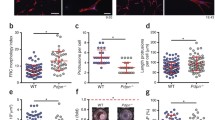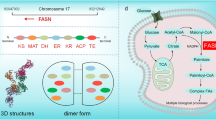Abstract
Fatty acids and their metabolites regulate immune cell function. The present study was undertaken to examine the detailed distribution of fatty acid binding proteins (FABPs), the cytosolic chaperones of fatty acids, in mouse peripheral immune organs. Using immunohistochemistry, FABP7 was localized to the alpha-smooth muscle actin (SMA)+ fibroblastic reticular cells, which construct the stromal reticula in the T cell areas of the peripheral lymph nodes and spleen. Immunoelectron microscopy showed that FABP7+ cells enclosed the collagen fibers, forming a conduit system, which transport lymph and associated low-molecular-mass proteins. In contrast, FABP5+ cells were distributed throughout the lymph node and contained well-developed lysosome and phagocytic materials within the cytoplasm. The mesenteric lymph nodes of FABP7 knockout mice showed normal histological features, but the percentage of CD4+ cells was significantly increased compared with that in wild-type mice. These data indicate that FABP7 may be involved in T cell homeostasis, possibly by modulating lipid metabolism in fibroblastic reticular cells within the peripheral lymph nodes.






Similar content being viewed by others
References
Abdelwahab SA, Owada Y, Kitanaka N, Iwasa H, Sakagami H, Kondo H (2003) Localization of brain-type fatty acid-binding protein in Kupffer cells of mice and its transient decrease in response to lipopolysaccharide. Histochem Cell Biol 119:469–475
Atkins GB, Wang Y, Mahabeleshwar GH, Shi H, Gao H, Kawanami D, Natesan V, Lin Z, Simon DI, Jain MK (2008) Hemizygous deficiency of kruppel-like factor 2 augments experimental atherosclerosis. Circ Res 103:690–693
Bajenoff M, Glaichenhaus N, Germain RN (2008) Fibroblastic reticular cells guide T lymphocyte entry into and migration within the splenic T cell zone. J Immunol 181:3947–3954
Balogh P, Fisi V, Szakal AK (2008) Fibroblastic reticular cells of the peripheral lymphoid organs: unique features of a ubiquitous cell type. Mol Immunol 46:1–7
Brix S, Lund P, Kjaer TM, Straarup EM, Hellgren LI, Frokiaer H (2010) CD4(+) T-cell activation is differentially modulated by bacteria-primed dendritic cells, but is generally down-regulated by n-3 polyunsaturated fatty acids. Immunology 129:338–350
Chetoui N, Boisvert M, Gendron S, Aoudjit F (2010) Interleukin-7 promotes the survival of human CD4 effector/memory T cells by up-regulating Bcl-2 proteins and activating the JAK/STAT signalling pathway. Immunology 130:418–426
Geissmann F, Manz MG, Jung S, Sieweke MH, Merad M, Ley K (2010) Development of monocytes, macrophages, and dendritic cells. Science 327:656–661
Gordon JI, Alpers DH, Ockner RK, Strauss AW (1983) The nucleotide sequence of rat liver fatty acid binding protein mRNA. J Biol Chem 258:3356–3363
Gorjao R, Azevedo-Martins AK, Rodrigues HG, Abdulkader F, Arcisio-Miranda M, Procopio J, Curi R (2009) Comparative effects of DHA and EPA on cell function. Pharmacol Ther 122:56–64
Gretz JE, Anderson AO, Shaw S (1997) Cords, channels, corridors and conduits: critical architectural elements facilitating cell interactions in the lymph node cortex. Immunol Rev 156:11–24
Haunerland NH, Spener F (2004) Fatty acid-binding proteins—insights from genetic manipulations. Prog Lipid Res 43:328–349
Hunt CR, Ro JH, Dobson DE, Min HY, Spiegelman BM (1986) Adipocyte p2 gene: developmental expression and homology of 5’-flanking sequences among fat cell-specific genes. Proc Natl Acad Sci USA 83:3786–3790
Junt T, Scandella E, Ludewig B (2008) Form follows function: lymphoid tissue microarchitecture in antimicrobial immune defence. Nat Rev Immunol 8:764–775
Kaldjian EP, Gretz JE, Anderson AO, Shi Y, Shaw S (2001) Spatial and molecular organization of lymph node T cell cortex: a labyrinthine cavity bounded by an epithelium-like monolayer of fibroblastic reticular cells anchored to basement membrane-like extracellular matrix. Int Immunol 13:1243–1253
Katakai T, Hara T, Lee JH, Gonda H, Sugai M, Shimizu A (2004a) A novel reticular stromal structure in lymph node cortex: an immuno-platform for interactions among dendritic cells, T cells and B cells. Int Immunol 16:1133–1142
Katakai T, Hara T, Sugai M, Gonda H, Shimizu A (2004b) Lymph node fibroblastic reticular cells construct the stromal reticulum via contact with lymphocytes. J Exp Med 200:783–795
Kitanaka N, Owada Y, Abdelwahab SA, Iwasa H, Sakagami H, Watanabe M, Spener F, Kondo H (2003) Specific localization of epidermal-type fatty acid binding protein in dendritic cells of splenic white pulp. Histochem Cell Biol 120:465–473
Kurtz A, Zimmer A, Schnutgen F, Bruning G, Spener F, Muller T (1994) The expression pattern of a novel gene encoding brain-fatty acid binding protein correlates with neuronal and glial cell development. Development 120:2637–2649
Ledgerwood LG, Lal G, Zhang N, Garin A, Esses SJ, Ginhoux F, Merad M, Peche H, Lira SA, Ding Y, Yang Y, He X, Schuchman EH, Allende ML, Ochando JC, Bromberg JS (2008) The sphingosine 1-phosphate receptor 1 causes tissue retention by inhibiting the entry of peripheral tissue T lymphocytes into afferent lymphatics. Nat Immunol 9:42–53
Maekawa M, Takashima N, Matsumata M, Ikegami S, Kontani M, Hara Y, Kawashima H, Owada Y, Kiso Y, Yoshikawa T, Inokuchi K, Osumi N (2009) Arachidonic acid drives postnatal neurogenesis and elicits a beneficial effect on prepulse inhibition, a biological trait of psychiatric illnesses. PLoS One 4:e5085
Maekawa M, Iwayama Y, Arai R, Nakamura K, Ohnishi T, Toyota T, Tsujii M, Okazaki Y, Osumi N, Owada Y, Mori N, Yoshikawa T (2010) Polymorphism screening of brain-expressed FABP7, 5 and 3 genes and association studies in autism and schizophrenia in japanese subjects. J Hum Genet 55:127–130
Mueller SN, Germain RN (2009) Stromal cell contributions to the homeostasis and functionality of the immune system. Nat Rev Immunol 9:618–629
Nasrollahzadeh J, Siassi F, Doosti M, Eshraghian MR, Shokri F, Modarressi MH, Mohammadi-Asl J, Abdi K, Nikmanesh A, Karimian SM (2008) The influence of feeding linoleic, gamma-linolenic and docosahexaenoic acid rich oils on rat brain tumor fatty acids composition and fatty acid binding protein 7 mRNA expression. Lipids Health Dis 7:45
Nourani MR, Owada Y, Kitanaka N, Abdelwahab SA, Iwasa H, Sakagami H, Spener F, Kondo H (2005) Localization of epidermal-type fatty acid binding protein in macrophages in advanced atretic follicles of adult mice. J Mol Histol 36:391–400
Owada Y (2008) Fatty acid binding protein: localization and functional significance in the brain. Tohoku J Exp Med 214:213–220
Owada Y, Kondo H (eds) (2003) Fatty acid binding proteins of the brain. Cellular proteins and their fatty acids in health and diseases. Wiley-VCH, Weinhem
Owada Y, Yoshimoto T, Kondo H (1996) Spatio-temporally differential expression of genes for three members of fatty acid binding proteins in developing and mature rat brains. J Chem Neuroanat 12:113–122
Owada Y, Suzuki R, Iwasa H, Spener F, Kondo H (2002a) Localization of epidermal-type fatty acid binding protein in the thymic epithelial cells of mice. Histochem Cell Biol 117:55–60
Owada Y, Takano H, Yamanaka H, Kobayashi H, Sugitani Y, Tomioka Y, Suzuki I, Suzuki R, Terui T, Mizugaki M, Tagami H, Noda T, Kondo H (2002b) Altered water barrier function in epidermal-type fatty acid binding protein-deficient mice. J Invest Dermatol 118:430–435
Owada Y, Abdelwahab SA, Kitanaka N, Sakagami H, Takano H, Sugitani Y, Sugawara M, Kawashima H, Kiso Y, Mobarakeh JI, Yanai K, Kaneko K, Sasaki H, Kato H, Saino-Saito S, Matsumoto N, Akaike N, Noda T, Kondo H (2006) Altered emotional behavioral responses in mice lacking brain-type fatty acid-binding protein gene. Eur J Neurosci 24:175–187
Pompos LJ, Fritsche KL (2002) Antigen-driven murine CD4+T lymphocyte proliferation and interleukin-2 production are diminished by dietary (n-3) polyunsaturated fatty acids. J Nutr 132:3293–3300
Rockett BD, Salameh M, Carraway K, Morrison K, Shaikh SR (2010) n-3 PUFA improves fatty acid composition, prevent palmitate induced apoptosis, and differentially modify B cell cytokine secretion in vitro and ex vivo. J Lipid Res 51:1284–1297
Roozendaal R, Mebius RE, Kraal G (2008) The conduit system of the lymph node. Int Immunol 20:1483–1487
Siegenthaler G, Hotz R, Chatellard-Gruaz D, Jaconi S, Saurat JH (1993) Characterization and expression of a novel human fatty acid-binding protein: The epidermal type (E-FABP). Biochem Biophys Res Commun 190:482–487
Storch J, Corsico B (2008) The emerging functions and mechanisms of mammalian fatty acid-binding proteins. Annu Rev Nutr 28:73–95
Suzuki R, Nourani MR, Saino-Saito S, Abe H, Nochi T, Kiyono H, Spener F, Kondo H, Owada Y (2009) Localization of fatty acid binding protein of epidermal type common to dendritic cells and presumptive macrophages in Peyer’s patches and epithelial m cells of mouse intestine. Histochem Cell Biol 132:577–584
Wall R, Ross RP, Fitzgerald GF, Stanton C (2010) Fatty acids from fish: the anti-inflammatory potential of long-chain omega-3 fatty acids. Nutr Rev 68:280–289
Watanabe M, Ono T, Kondo H (1991) Immunohistochemical studies on the localisation and ontogeny of heart fatty acid binding protein in the rat. J Anat 174:81–95
Willard-Mack CL (2006) Normal structure, function, and histology of lymph nodes. Toxicol Pathol 34:409–424
Acknowledgments
We are grateful to Dr. K. Udo, Mr. M. Tamechika, Dr. N. Yamamoto-Kitanaka, Dr. K. Yamaguchi, Dr. J. Kitoh, Dr. K. Ishii, Ms. A. Osaki and Mr. T. Nawata for their technical assistance. This work was supported in part by grants from the Ministry of Education, Science and Culture of Japan, nos. 20590191 (to N. T.), 19790152 (to Y. A.), 19659369 (to T. S.), 19590189 (to Y. O.), from the New Frontier Project Research Fund of Yamaguchi University Graduate School of Medicine in 2009 (to N. T.), and from the Yamaguchi University Research Project on STRESS.
Author information
Authors and Affiliations
Corresponding author
Electronic supplementary material
Below is the link to the electronic supplementary material.
418_2010_754_MOESM2_ESM.tif
Supplementary Fig. 1 Gene expression of FABP7 in the mouse mesenteric lymph node (MLN). By RT-PCR analysis, the gene expression of FABP7 was detected clearly in MLN. The expression in the neonatal cerebrum and cerebellum were shown as positive controls (TIFF 49 kb)
418_2010_754_MOESM3_ESM.tif
Supplementary Fig. 2 Localization of FABP7 and CD31 in the paracortex of mouse mesenteric lymph node. Note that CD31 immunoreactivities were observed in the endothelial cells of high endothelial venules (a) and capillary vessels (b), both of which were FABP7 negative. Scale Bar, 20 μm (TIFF 623 kb)
418_2010_754_MOESM4_ESM.tif
Supplementary Fig. 3 Flow cytometry analysis of CD4 and CD8 expression in mesenteric lymph node and spleen cells from WT and FABP7 KO mice. The numbers in each quadrant indicate the percentage of cells. Data are representative of six to nine independent experiments (TIFF 134 kb)
Rights and permissions
About this article
Cite this article
Tokuda, N., Adachi, T., Adachi, Y. et al. Identification of FABP7 in fibroblastic reticular cells of mouse lymph nodes. Histochem Cell Biol 134, 445–452 (2010). https://doi.org/10.1007/s00418-010-0754-2
Accepted:
Published:
Issue Date:
DOI: https://doi.org/10.1007/s00418-010-0754-2




